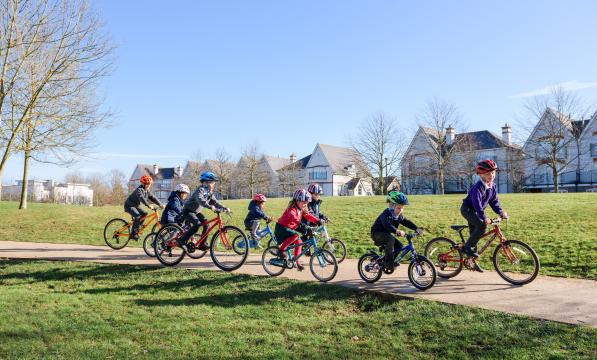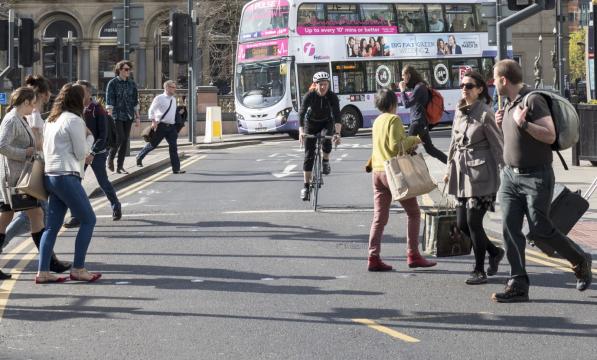Cycling to school

“You must be mad!” was the frequent response when I was a School Travel Plan Adviser at Hackney Council, talking to parents about cycling to school with their kids. “Look at the state of the roads!” they’d say, referring to the lumbering double-decker buses, careering tipper trucks, zooming mopeds, a myriad of manic cars and gaggles of older pupils spilling out into the road.
When coupled with today’s anxiety about stranger danger, and the criticism thrown at parents who let their children cycle unaccompanied, it’s no wonder that the numbers of UK pupils cycling to school plummeted in the 1970s and ’80s.
Sadly, this means that children are transported to school by other modes – particularly by car, the use of which has doubled on the school run during the last 20 years. Childhood obesity has doubled over roughly the same period.
In 1995-97 the proportion of cars on the roads between 8 am and 9 am that were ferrying children to school was 10%. By 2009, the National Travel Survey shows it had risen to 21%. Everyone notices the extra traffic in September when the kids go back to school.
Getting schools cycling
It’s not all bad news. As well as government-run School Travel Plans and the legal requirement for local authorities to have Sustainable Modes of Travel to School (or SMOTs – no, not something that might fly into your eye!), there are now many schemes that are encouraging children and parents to cycle to school.
Mark Kiehlmann lives in Bishopbriggs, East Dunbartonshire, and has tirelessly pushed for cycling to school initiatives. He’s now running three ‘cycle trains’ (think: walking bus) to St Matthew’s Primary School.
“It’s all about the parents,” he insists, having explained that the headteacher has been extremely supportive about overturning the local authority’s restrictive approach of preventing pupils from riding in until they had undergone cycle training, which used to be so late in the primary school system that children weren’t cycling to secondary school because they’d never had any practice.
“If we can get them really young – and that means five or six – cycling on the pavement, accompanied by adults on the road, then they can cycle the same distance as the whole of Land’s End to John O’Groats by the time they finish primary school,” says Mark, who was Cycling UK’s Volunteer of the Year for 2009.
He knows that his approach is a bit contentious, but maintains: “Unless we have decent cycle paths, it’s simply not viable for very young children to be cycling to school – and why should we be preventing them? My five year old wanted to do it, and now at our family cycling clubs we have small children cycling 40 or 50 miles, no problem.”
Parental support
Mark has got six parents who already cycle with their kids to school (and then on to work) to run the cycle trains, which have proved reliable and popular. This, and his work on providing family bike rides and training at the weekends over a three-month period for two years in a row now, has meant he is really looking forward to the travel to school data this September.
“We now have the most cycle-friendly schools in Scotland here in Bishopbriggs,” he states, “and we’ve spread the activities at St Matthew’s to other schools in the area. It’s down to funding and committed individuals – and teaching at least three adults to ride has meant that cycling by the kids is now completely realistic. We’ve even got the female coordinator of an Asian women’s group ready to become a Bikeability cycle instructor.”
In east London, where I live, STA Bikes in Hackney have been teaching parents – particularly mums – and children to ride together for a number of years.
Key member Gail Bristow explains that “our focus is as much on improving people’s lives as it is on cycling,” by means of involving hard-to-reach groups such as those on very low incomes, those from ethnic backgrounds that have less propensity to cycle, and targeting mums to be trained both to ride and then to become cycle instructors themselves.
“They can then be role models for their communities,” says Gail, whose children cycle to the local primary school.
Mums have a huge sway over family travel decision-making. It’s vital to get them cycling confidently so they can deal with traffic and are confident their kids can too
Gail Bristow, member of STA Bikes
Incentives and deterrents
Perceived traffic danger and a lack of cycling skills are not the only problems facing children or parents wishing to cycle. I remember my secondary school days well. Witless timetabling resulted in one day of the week requiring not only my usual school bag bursting with heavy textbooks, but my violin, PE kit and – on the way home – the usually inedible results of home economics.
In addition, the rusty bike sheds of our youth may now seem entirely inadequate for the security requirements of today’s flashy bikes. Or they may even be demolished to make way for something deemed more important – perhaps more staff car parking spaces. Some schools may even ban cycling by pupils altogether.
One Hackney secondary school banned cycling in 1982 because a pupil fell off and broke his arm. Schools can’t legally ban pupils cycling on the public highway, but Cycling UK has been involved in numerous cases of schools effectively preventing children from cycling in by banning bikes being chained up on the premises.
Bikeability training
There’s a more fundamental problem. As well as driver behaviour, speed of cars, sheer volume of traffic and a road layout that appears to have completely forgotten about cycling, many children have never been taught to ride properly – or even at all – by their parents.
Parents may have no cycling experience, or perhaps experienced poor cycling tuition. I remember our cycling proficiency volunteer urging us to ‘hug the kerb’ – not very good advice if you want to be seen.
If they are lucky enough to have a bike – many children in inner urban areas don’t own one – it may be cheap, clunky, poorly made, and even badly put together by someone with a lack of skills who’s been tasked with assembling a ‘bike-in-a-box’ from the internet.
These ‘lost generations’ are where Bikeability comes in – cycling proficiency for the 21st century, developed by Cycling UK and others. These professional national standards take both children and adults through the whole process of learning to ride with confidence in a real street environment.
It even goes through how you can check your bike to ensure it’s safe before you ride, and many courses make minor adjustments to children’s bikes such as making the brake levers easier for little hands to reach, putting the saddle at a suitable height, and the never-ending pumping up of squidgy tyres.
A Bikeability survey showed that up to 80% of children would prefer to cycle to school
Alix Stredwick, Carry Me Bikes
Riding to school together
Myra Van Inwegen, her husband and their two young children live in Girton, a village about two miles from the centre of Cambridge. Myra uses the family’s Thorn Voyager childback tandem to get the kids around, with Ellen (7) riding on the back of the tandem, and Luke (4) in a Burley D’Lite trailer towed behind. “Luke is really excited about being promoted to the back of the tandem as a stoker when Ellen is riding her own bike to school,” says Myra.
It’s not that far to most primary schools, even with ‘parental choice’ meaning that you can send your child to a school the other side of the county if it’ll have them. Myra explains: “Ellen’s school is about one-and-a-half miles away, and we do have a car. But it sits on the driveway most of the time. Our bike arrangement gets us to school, to town, and beyond, perfectly.”
Distance to school varies a lot with age. A report for the Department for Work and Pensions in 2009 stated that almost half of all pupils live within a mile of their school, and less than one quarter lived three or more miles away. Primary schools are smaller and therefore more plentiful and evenly distributed, so average distance away is less than a mile for over two thirds of children between age five and 10.
The Work and Pensions survey revealed that, for those of secondary school age, only 38% of pupils lived within a mile. As the distances are longer, more pupils take the bus or are given a lift – just when they are more likely to have the skills and confidence to cycle to school.
Precious cargo
With pre-school children, a child seat, trailer or cargo cycle may be a better option for cycling together, and the latter can be useful for primary school pupils too. One in four families with two children living in the cycling heaven that is Copenhagen owns a cargo bike, and nearly a quarter of all owners say that they use one to replace a car.
The ubiquitous Christiania cargo trikes have become so popular that the Copenhagen Bicycle Account report of 2008 makes an ‘obvious guess’ that the congestion they cause on the city’s excellent cycling facilities is why cyclists’ satisfaction with the width of cycle tracks has reduced by 20% since 2006!
The city is taking the issue of cargo trike storage so seriously that it has been trialling an on-street lockable storage facility for up to four trikes. The store fits into one car parking space.
Cargo bikes are less well known in the UK. Yet there are pockets of popularity in Britain. In Cambridge a bike shop called The School Run Centre has opened, showcasing a myriad of examples which you can try out for yourself.
In west London, Ealing Cycling Campaign has run an excellent loan scheme funded by a local trust. Trailers, child seats, and bicycle buggies have been available, along with advice and cycle training, for people who “are left without a car when they start a family, as the other partner may use the car for work,” explains ECC coordinator David Eales.
“They then realise how difficult public transport can be with a very young child and the associated equipment of prams, bottles, spare clothing and so on. Cycling with the appropriate kit suddenly seems so much more convenient.”
Bram Gerrits and his partner Mirjam Langeveld have a little boy who’s just turned three. They recently moved to the UK from the Netherlands, and get about using a De Fiets Fabriek two-wheeled cargo bike with the box at the front, plus a regular bike with a child seat on the back.
“Here in Cambridge I more or less go everywhere with Marius on the cargo bike,” says Bram. “Nursery, supermarket, swimming pool… We keep the bike, rather than the car, in the garage. The car stays outside.”
Mirjam, with the child seat on the back of her bike, is a little more circumspect. “The roads here are less made for bikes than in The Netherlands. It feels very cramped for bikes here,” she observes grimly, despite cycling in Cambridge, a (relatively) cycle-friendly city. “There are far fewer cars in Amsterdam. If we’re to reduce school run motor traffic in the UK too, cycling has to play to a role.”




